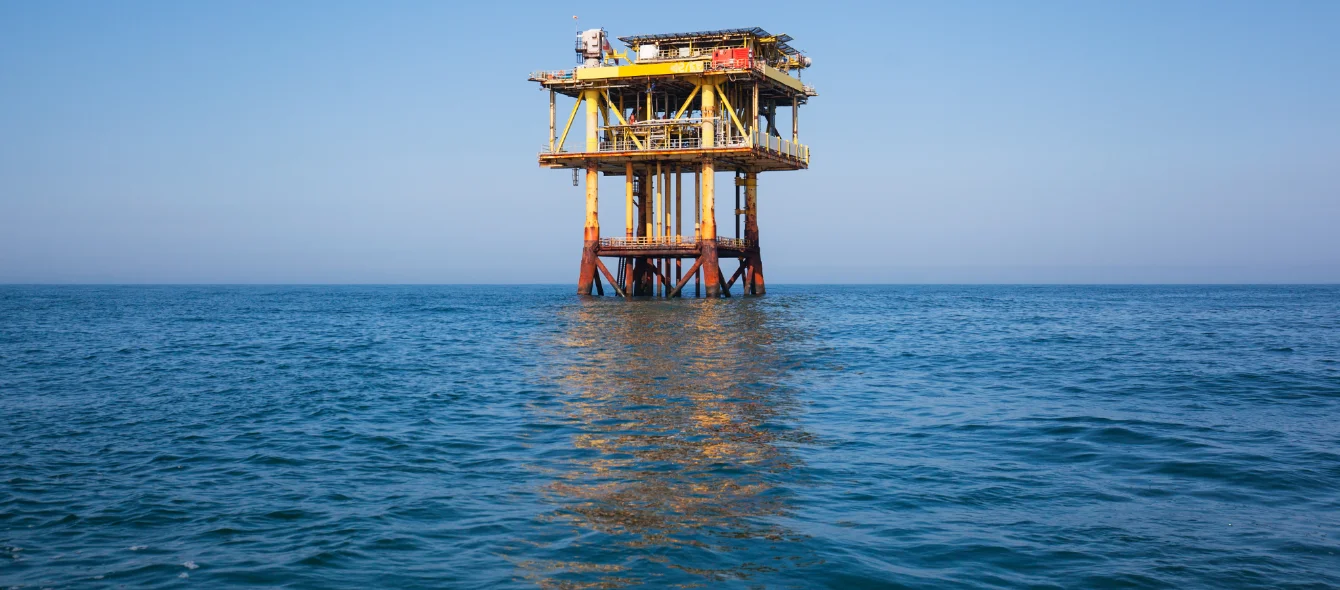
Oil platforms like this one off the coast of the UK still play an important role for Great Britain. With the net-zero target in mind, the new "North Sea Transition Deal" now also wants to work on rapidly reducing greenhouse gas emissions generated by the extraction of oil and gas.
© shutterstock.com, Lukasz Z
In March, the UK government laid out a plan to transform the North Sea oil and gas basin. From a major source of greenhouse gas emissions, by 2050, it is to become a carbon neutral area.
Some would label this ‘mission impossible’, arguing that the notion of an oil and gas basin is simply incompatible with a net zero carbon future. Environmental organisations, for example, have called for an immediate end to the award of new oil and gas licenses, a policy which the North Sea Transition Deal does not adopt.
Oil and gas production from the North Sea will continue to decline, having already peaked around the turn of the century. However, forecasts made by the UK’s Climate Change Committee suggest the UK will need oil and gas for decades to come, albeit in decreasing quantities, as the energy transition picks up speed and scale.
Moreover, the transition deal recognises that many people’s livelihoods depend on oil and gas and that the sector has many assets – skills, expertise, offshore experience and infrastructure – which can be repurposed to support and become part of the energy transition.
Objective alignment
The first major change of direction has already been made at the top. Formerly tasked with maximising the economic recovery of the North Sea’s oil and gas resources, the Oil and Gas Authority (OGA) in December last year submitted a new strategy. This included for the first time obligations on the industry to operate in a manner consistent with the government’s ambition to reach climate neutrality by 2050 and to make serious progress on unlocking net zero solutions.
The North Sea Transition Deal, which was formulated in cooperation with OGA and OGUK, the oil and gas sector’s representative organisation, covers in more detail what these solutions might be.
The deal has three major components – supply decarbonisation, Carbon Capture, Utilisation and Storage (CCUS), and hydrogen. In turn, the development of these components will mean a transformation of the sector’s existing supply chain and the creation of new jobs and opportunities as the focus of the basin’s activities moves away from fossil fuel production.
Supply decarbonisation
With net zero by 2050 the overall target, the transition deal looks first at supply decarbonisation, in effect relatively near-term emissions reductions from the process of producing oil and gas. It sets targets to reduce emissions from upstream oil and gas by 10% by 2025, 25% by 2027 and by 50% by 2030 relative to a 2018 baseline.
There are a number of avenues to achieve this goal, such as phasing out routine flaring and venting, electrifying platform operations to displace on-site oil and gas use, upgrading equipment and machinery to improve energy efficiency and phasing out high emission assets. This component will include a Methane Action Plan.
An example from the Norwegian oil and gas sector is the 88 megawatts Hywind Tampen offshore wind project, which is designed to supply renewable power to the Snorre and Gullfaks oil and gas platforms.
CCUS
The UK has more potential CCS sites than the rest of Europe put together. Their offshore location eliminates hazards to local populations and opens up access to carbon dioxide shipped or piped from other countries, effectively turning carbon storage into an international service. According to the transition deal, CCUS has the potential to support up to 50,000 jobs in the UK by 2030. The government has committed $1 billion to facilitate operational CCUS in four industrial clusters by 2030.
The oil and gas sector is to lead CCUS development by leveraging existing infrastructure to provide carbon transport and storage facilities, as well as working across sectors to develop carbon capture technologies.
CCUS is also expected to play a fundamental role in the third major component of the transition deal – hydrogen. The government has set a target of 5 gigawatts of clean hydrogen capacity by 2030 and will create a Net Zero Hydrogen Fund to support low-carbon hydrogen production. Low carbon hydrogen can be produced via electrolysis using renewable power or steam reforming natural gas in combination with CCUS. The government is expected to publish its hydrogen strategy in the first half of this year.